As the most expensive superbike of the bunch, Ducati’s Panigale S has a lot of work to do to justify its price tag. Ducati has always had a history of drawing non-biker’s attention, and that’s part of the allure of owning one. The Ducati is instantly recognisable, yes, but there is also something about riding the thumping V-twin that sends endorphins running and causes goosebumps to rise every time that throttle is twisted, creating a special vibe that only a machine of this calibre has.
The Panigale has been in production since 2011 and has received major improvements over the years. It increased in capacity to its current 1285cc in 2015, making it a real torque monster and adding a lot of excitement to an already glowing package.
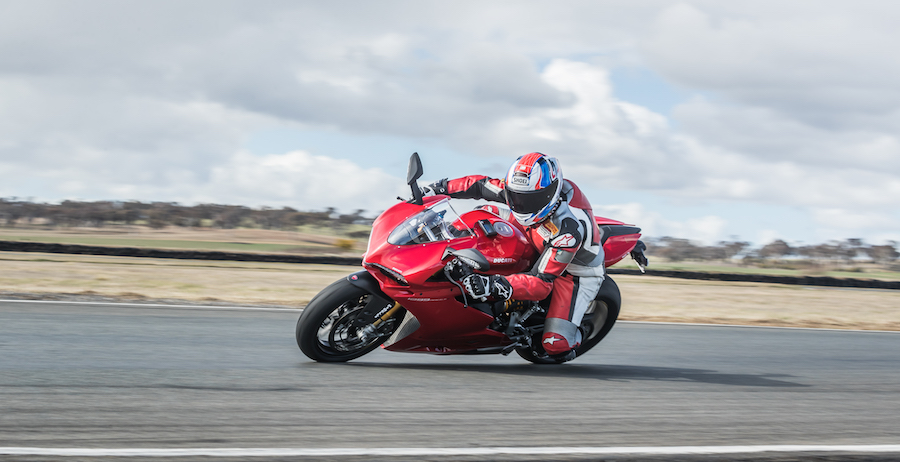
The Ducati is the most technically different to the other AUSTest bikes in many ways. It’s the only V-twin, it’s the only bike without an alloy spar frame, and it boasts some pretty special features to boot. Its highly developed 90º powerplant has a vacuum pump to reduce pressure inside the engine for more revs and power. It’s got semi-active suspension and the same NIX30 fork and TTX36 shock as the Honda, but the shock is mounted on the left of the bike where ride height can be changed in an instant and even the rear link ratio is adjustable – something not possible on the others.

This year’s S was the lightest bike on test and that showed on the racetrack, where the deceptive Ducati let the rider get every ounce of power to the ground. It wasn’t too shabby at the drag strip either, putting in sub-10 runs and finishing third fastest for the day. The race-oriented electronics package worked perfectly with a smooth throttle and no unnecessary intervention, putting it ahead of the Japanese manufacturers.
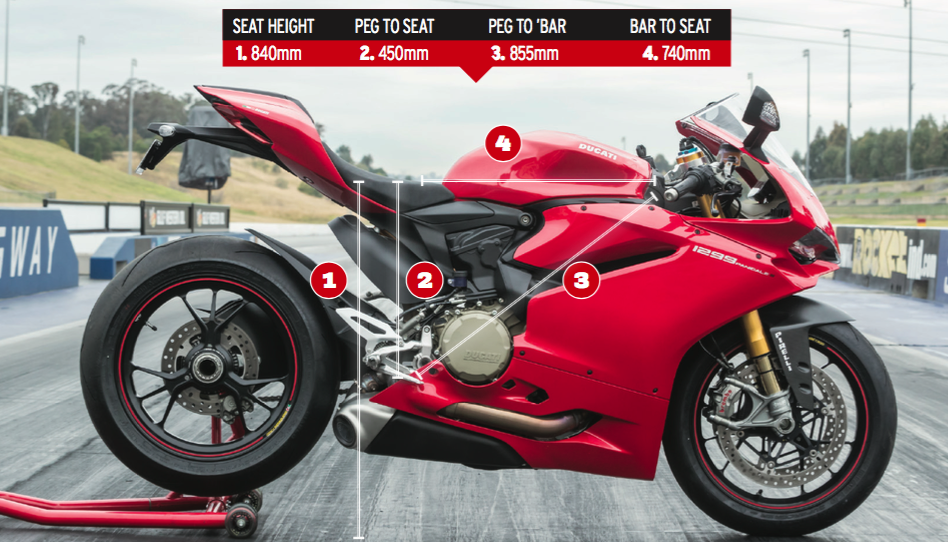
The Panigale S is a bike with two personalities. Heading down the main street at 50km/h it feels like a thoroughbred racehorse straining to hold its composure – there’s a lot of power under that fairing waiting to break loose. The strange part is the way it can turn itself from animal to pussycat when you do get serious. It feels slow but it’s not; the Panigale knows when to show and when to go.
We found the Ducati needs to make an arc to work when cornering, and it wouldn’t change line like the fours. The arc system allowed so much corner speed though and it was just a matter of getting your head around the intricacies of the Panigale to let it reach its potential.
It’s a bike that needs a riding style to make it work, but if you crack it, it’s as fast as anything.

Three things
- Info on the TFT dash includes engine mode, TC, wheelie control, engine braking and ABS settings
- Side-mounted rear shock is a blessing for racers who want to make a quick adjustment
- The sidestand on the Panigale tucks in well, but it’s difficult to put down unless you actually get off the bike first
Second Ops
Aidan Hayes
The Ducati was nothing like I expected it to be. I felt confident on the track, the drag strip, and on the road. When accelerating or cornering this bike is so stable – it holds a line well but will run wide if your line is wrong as it is a little harder to change course mid-turn. I think it’s a bike you need to spend time with to get the most out of. The sidestand is tucked up well out of the way so no chance of scrubbing it out on maximum lean angle, but it needs a knob so you can find it.

Harley from RB Racing says…
At near on 1300cc, the Ducati makes the most power of all the bikes tested. There is a drop in torque at 5000rpm, and below 3000rpm it gets a bit hard to manage because it really just wants to rev, but beyond there it builds power at an amazing rate, all the way to the limiter. The massively oversquare engine makes the Ducati feel properly angry, while the transmission feels almost Japanese, with none of the clunkiness often associated with European twins.
On our dyno Power 138.86kW Torque 133.03Nm
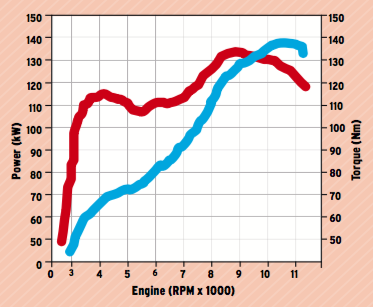

Price
$35,490
Power
138.86kW Torque
133.03Nm
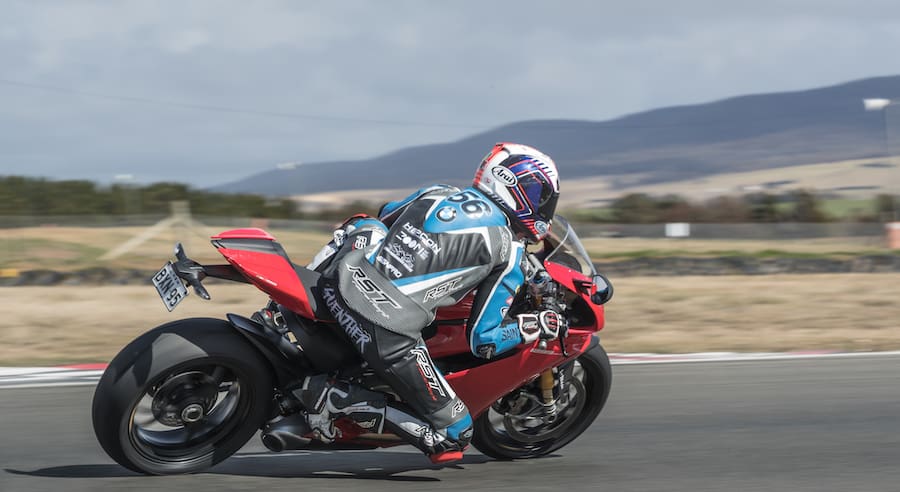
2017 AMCN AUSTest
Once it was the kind of cutting-edge technology you’d find only on MotoGP and WSBK bikes; now electronic assist systems and dynamic suspension are the rule for all big-bore production superbikes, not the exception.
In our last AUSTest, back in 2015, we celebrated the rebirth of the superbike, when the world’s top manufacturers pulled themselves out of the GFC doldrums and got back to work creating proper one-litre speed machines. Bugger the cost, and bugger the practicality they said.
Two years later, the world’s fastest and most desirable machines have morphed once more. With big-bore nakedbikes becoming the machine of choice for the regular rider wanting usable power, handling and looks in a package they can live with day to day, production superbikes have become the Ferraris and Lamborghinis of the motorcycling world. Crammed full of power, performance and electronics few will ever fully test, and riding on a suspension package that can adjust itself on the fly, these machines are gorgeous examples of what is possible, yet are impractical for the road – and that’s why we love them.
In another first for AUSTest, every bike tested this year sits well over the $20,000 mark. If your five-figure budget begins with a 1, you are out of luck. All that technology comes at a cost, but as you are about to discover, a higher price mostly offers better value for money.
While the evolution of the superbike has continued unabated, one thing returning to the way of old is how we conduct AUSTest. For 2017, we were back in NSW and invited manufacturers to be hands on, requesting each deliver their bike accompanied by a factory-trained technician to help our test riders find the best possible set-up. Such is the high regard the manufacturers have for the AUSTest title, most sent multiple staff and the show looked more like a round of the ASBK than a shootout. That’s fitting, considering our AUSTest combatants often go head to head on the track.
In the end, there can be only one winner, and over the next 26 pages we will take you through the exhausting testing process. Then, when you think you have the winner sussed, we will reveal our champion. Enjoy the ride – we certainly did.
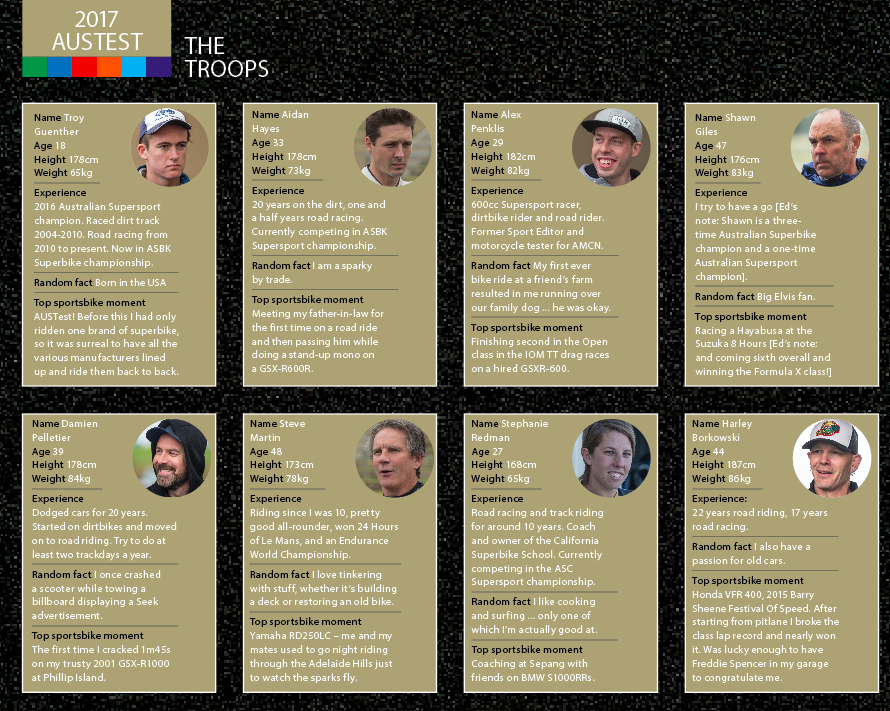
Day 1
Sydney Dragway
It’s a known fact that there’s no quicker way to get away from the lights than to use a machine producing in excess of 130kW and weighing just 200kg. Now, imagine a set of traffic lights where you don’t need to shut the throttle before changing to second gear and obliterating the speed limit. Such a place exists at Western Sydney. With a surface as sticky as shit on a blanket, and electronic timing with reaction times and speed traps, it’s a quarter mile of international-standard heaven that hosts some of the fastest drag bikes and cars in the world.
We lined our six AUSTest combatants up two at a time to test their launch and wheelie control, and of course, to see which could cover the quarter mile distance in the quickest time at the fastest speed. Before getting underway, those in the know said that a low 10-second pass would be impressive.
What eventuated left the experts gobsmacked.
Day 2
Wakefield Park Raceway, Goulburn
A regular stop on the ASBK circuit, Wakefield Park is tight and technical – an evil-handling bike will quickly be found out on the undulating 2.2km circuit. Throw in strong winds and unpredictable weather, and you need to be on the ball.
For a full day we rotated the six AUSTest bikes through the hands of the eight track-test riders. As conditions improved, and the technicians fine-tuned the bikes, the lap times began to drop. While there are no AUSTest points on offer for the fastest lap, there are definitely bragging rights, and everyone wanted them.
We won’t spoil the surprise, but we will say that the lap times set would have seen our stock-standard AUSTest entrants line up mid-grid at an ASBK round. Impressive stuff.
Day 3
Road ride, Goulburn to Sydney
The chosen route was 400km-plus of tight twisty and open country road special stages connected by freeway hops, all packed into a non-stop day. This provided the riders with a chance to sample each bike in the environment where it will be most used. An uncomfortable seating position or snatchy fuelling will always be revealed on a road ride. AUSTest titles have been won and lost in this section of the test.
Day 4
On the dyno
Are the claimed numbers bullshit? There is only one way to find out: with a dyno.
Our final destination for AUSTest 2017 was RB Racing at Caringbah where Harley Borkowski ran each of the bikes on the dynamometer to measure kW and Nm output. Harley was also one of our test riders this year, giving him the unique opportunity to see if the dyno numbers correlated to what the seat of his pants said.

THE METHOD
Who buys a superbike? A snapshot of the current superbike buying public will reveal possibly one of the widest demographics of any genre. Everyone from riders graduating from a restricted licence through to those who have worked long and hard enough to afford a few luxuries in life are buying superbikes. Highly skilled riders and racers buy them, as well as people who just want to look like Messrs Márquez, Rossi and Lorenzo at the local café – and drool over what a production superbike has to offer. AUSTest is as much about real-world performance and looks as it is about race pedigree and lap times, so we assembled a group of riders that represent the broad spectrum of superbike buyers. Daily riders, trackday junkies, endurance champs, national-title winners, professional test riders and young guns presently contesting the national Superbike and Supersport categories all made up the eight-rider test team charged with the task of determining who made the best two-wheeled missile for the best price.
Each rider was given two sessions on each bike on the drag strip, track and the road. Then they were handed an extensive voting form covering everything from how the bike performed and how it made them feel, through to value for money and which bike simply did it for you – regardless
of the cost.
While quarter-mile sprint and track lap times provided an indication of performance as well as plenty of entertainment and all-important bragging rights, it’s the results from the points-based voting sheets that determined the AUSTest 2017 champion.
Tyres
In years past we have experimented with a control tyre for AUSTest. While the idea works in theory, in reality most manufacturers have a commercial agreement with a tyre manufacturer, and the bike is developed using those tyres. If you are a superbike owner keen to cut some serious laps at a trackday, you will be faced with a few brand and rubber compound choices. To simulate a real-world situation, we left tyre choice to the manufacturers. As long as the tyre was DOT approved and available in Australia it was good to go.
Each manufacturer’s choice of tyre for AUSTest is provided on the test results. Most used just the one set of tyres for the drag strip and trackday, reverting to the OEM tyres for the road ride.
Timing
Each bike’s best quarter-mile time and top speed, as well as its fastest lap time on the track, do not form part of the voting criteria for AUSTest 2017, so this information is irrelevant – said no sane motorcycle lover ever. The minute the first bike shot down the quarter mile at Sydney Dragway or turned the first lap at Wakefield Park, everyone had their stopwatch out.
Sydney Dragway has its own timing system, but for Wakefield Park we needed something reliable, easy to install and easy to understand, that provided results instantly. The SpeedAngle lap timer ticked all these boxes. The team from SpeedAngle provided a unit for each bike, and even programmed the name of each model into the system so there could be no mix-ups. All six units performed faultlessly throughout the day, capturing every lap of every session.












